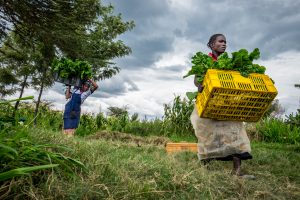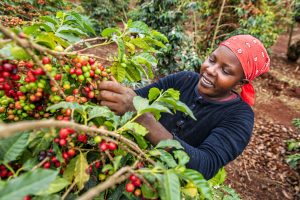
This is the third of our five-part blog series on engaging the private sector in National Adaptation Planning (NAP) processes. Stay tuned for the fourth installment of this series on June 26, 2019. To learn more, read our guidance note on the subject.
Most farmers in Kenya are smallholders: they own and work on plots of land that are on average less than three hectares in size. For these farmers, a changing climate poses a significant challenge to their lives and livelihoods.
The challenge is immense, but the farmers can adapt: they can plant shade trees to protect their coffee crops from the blistering sun; they can switch to drought-resistant strains of cassava and sorghum; or they can increase the efficiency of their water harvesting systems. Such climate-smart agriculture techniques can be vital to ongoing adaptation efforts for this crucial segment of the national economy. And Kenya’s National Adaptation Planning (NAP) process recognizes climate-smart agriculture as a key priority for enhancing the resilience of the country’s agricultural value chains. However, designing and implementing these responses will require not only the right level of capacities, but also the appropriate financing.
Many private enterprises—and especially micro, small and medium-sized enterprises—may have limited access to financial resources to pursue adaptation actions. For many private sector actors, including smallholder farmers, accessing the appropriate level and type of financing to pay for their adaptation efforts can be difficult, even if the benefits to engagement are apparent. They may need financing to pay for investments in climate-proofing their operations, for example, or to bring new goods and services to the market that support resilience. However, accessing that financing can be impossible for many: they may not have the required collateral or may not be able to support high interest rates.

Ensuring that private sector actors have access to reliable financing to pay for adaptation actions and that appropriate financial instruments are made available to them will be integral to enabling private investments in a country’s longer-term adaptation goals and programs, including the NAP process.
Governments can help here. They can, for example, provide incentives that promote adaptation investments, including tax breaks. They can offer risk guarantees and can use procurement contracts that help secure the demand for climate-resilient products and services. Governments can use mechanisms like taxes, levies, fees and royalties to raise funding that allows financial support to be offered for climate risk assessments; extension services; and start-up or seed financing for new products and services. They can also use a variety of de-risking instruments—including partial credit guarantees, political risk guarantees and blended finance—to help bear the risk of adaptation investments, particularly for large-scale investments.
Accessing the appropriate kind of financing is another key challenge. Financiers and enterprises may be operating in imperfect capital markets that are unable to efficiently allocate capital or transfer risk. It is important that a variety of financial instruments suited to different types of adaptation investments are made available—financing, for example, that can cover short-term and long-term investments, or internal and external investments in adaptation. For example, there is often a shortage of longer-term credit in many financial markets, inhibiting the ability of companies to finance the investments required to cope with longer-term or distant climate impacts.
Enabling private sector access to finance should be a key part of the NAP planning and implementation process. This could include the development by the government of a NAP financing or resource mobilization strategy, keeping in mind that it is crucial that private sector actors be included in drafting these strategies, to ensure their priorities and interests are heard and incorporated.

In Kenya’s NAP document, developing fiscal incentives for private sector investment in adaptation has been identified as a medium-term sub-action moving forward. The government is already working toward this aim, in part through its support of the Finance Innovation for Climate Change Fund (FICCF). FICCF has sought to overcome many of the barriers to financing adaptation in its promotion of private sector investments in climate-smart agriculture. The fund does so in part by providing repayable grants to microfinance institutions for on-lending to smallholder farmers and aggregators, so that they can invest in climate-smart technologies and practices. The Kenyan government is helping the initiative by providing reliable access to data and information on current and forecasted weather and climate.
Private sector engagement will be essential to the success of the NAP process, whether through direct financing or active participation in adaptation actions. Governments can play a key role in enabling this private sector engagement by promoting a number of enabling factors.
In addition to promoting information sharing (released last week) and ensuring access to appropriate financing, in the next few weeks, we will also explore other enabling factors, including capacity building and institutional arrangements.
Any opinions stated in this blog post are those of the author and do not necessarily reflect the policies or opinions of the NAP Global Network, its funders, or Network participants.
Read other parts of this blog series:
-
What is the Business Case for Private Investment in the NAP Process?
-
Knowledge is Power: Why information sharing is key to engaging businesses in the NAP process
-
For MSME Day, We Look at How Institutional Arrangements Can Engage Small Businesses in Climate Adaptation
-
When Life Gives You Lemons: How to bolster businesses’ capacity for making lemonade out of a changing climate
Find out more about our work on Financing NAPs.